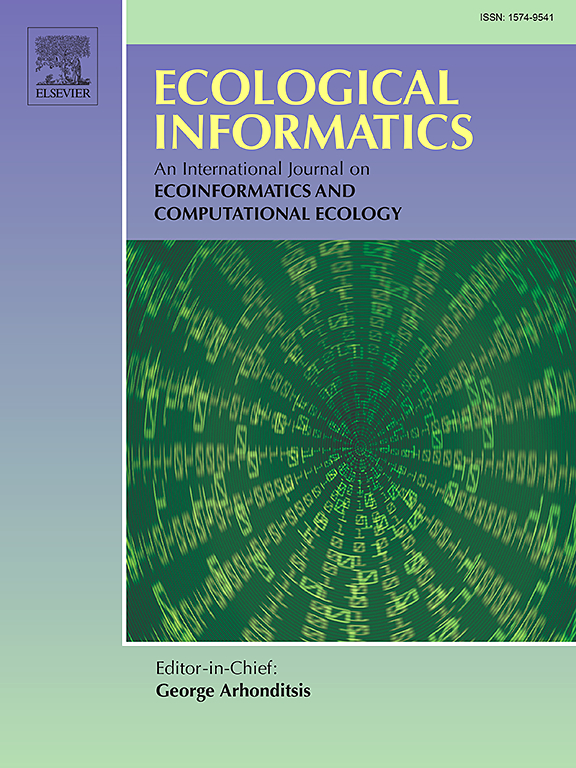Integration of national demographic-disturbance relationships and local data can improve caribou population viability projections and inform monitoring decisions
IF 5.8
2区 环境科学与生态学
Q1 ECOLOGY
引用次数: 0
Abstract
Across fifty-eight boreal caribou study areas in Canada, survival and recruitment decrease with the percentage of the study area that is disturbed. There is variation in demographic rates among study areas, particularly where anthropogenic disturbance is low, but no populations inhabiting areas with high anthropogenic disturbance are considered viable. Demographic projections derived from local population-specific data are uncertain for populations with limited monitoring. We propose a simple Bayesian population model that integrates prior information from a national analysis of demographic-disturbance relationships with available local demographic data to improve population viability projections, and to reduce the risk that a lack of local data will be used as a reason to delay conservation action. The model also acknowledges additional uncertainty and potential bias due to misidentification of sex or missing calves, through a term derived from a simple model of the recruitment survey observation process. We combine this Bayesian model with simulations of plausible population trajectories in a value of information analysis framework to show how the need for local monitoring varies with landscape condition, and to assess the ability of alternative monitoring scenarios to reduce the risk of errors in population viability projections. Where anthropogenic disturbance is high, reasonably accurate status projections can be made using only national demographic-disturbance relationships. At lower disturbance levels where initial uncertainty is high local data improve accuracy but each additional year of monitoring provides less new information. The estimated probability of viability indicates whether more information is needed to improve accuracy of population viability projections.
整合国家人口扰动关系和当地数据可以改善北美驯鹿种群生存能力预测,并为监测决策提供信息
在加拿大的58个北方驯鹿研究区域中,随着研究区域受到干扰的比例的增加,驯鹿的生存和数量也在减少。研究区域的人口比率存在差异,特别是在人为干扰低的地区,但没有人口居住在人为干扰高的地区被认为是可行的。对监测有限的人口来说,从当地特定人口数据得出的人口预测是不确定的。我们提出了一个简单的贝叶斯种群模型,该模型将来自全国人口扰动关系分析的先验信息与可用的当地人口数据相结合,以提高种群生存能力预测,并降低因缺乏当地数据而被用作推迟保护行动的风险。该模型还承认额外的不确定性和潜在的偏见,由于性别的错误识别或丢失的小牛,通过一个术语从招募调查观察过程的简单模型派生。我们将该贝叶斯模型与信息价值分析框架中合理的种群轨迹模拟相结合,以显示局部监测需求如何随景观条件而变化,并评估替代监测方案的能力,以减少种群生存能力预测中的错误风险。在人为干扰高的地方,仅使用国家人口-干扰关系就可以做出相当准确的状态预测。在干扰程度较低,初始不确定性较高的情况下,当地数据提高了准确性,但每增加一年的监测提供的新信息较少。生存力的估计概率表明是否需要更多的资料来提高人口生存力预测的准确性。
本文章由计算机程序翻译,如有差异,请以英文原文为准。
求助全文
约1分钟内获得全文
求助全文
来源期刊

Ecological Informatics
环境科学-生态学
CiteScore
8.30
自引率
11.80%
发文量
346
审稿时长
46 days
期刊介绍:
The journal Ecological Informatics is devoted to the publication of high quality, peer-reviewed articles on all aspects of computational ecology, data science and biogeography. The scope of the journal takes into account the data-intensive nature of ecology, the growing capacity of information technology to access, harness and leverage complex data as well as the critical need for informing sustainable management in view of global environmental and climate change.
The nature of the journal is interdisciplinary at the crossover between ecology and informatics. It focuses on novel concepts and techniques for image- and genome-based monitoring and interpretation, sensor- and multimedia-based data acquisition, internet-based data archiving and sharing, data assimilation, modelling and prediction of ecological data.
 求助内容:
求助内容: 应助结果提醒方式:
应助结果提醒方式:


